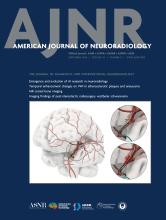This article requires a subscription to view the full text. If you have a subscription you may use the login form below to view the article. Access to this article can also be purchased.
Abstract
BACKGROUND AND PURPOSE: Feature variability in radiomics studies due to technical and magnet strength parameters is well-known and may be addressed through various preprocessing methods. However, very few studies have evaluated the downstream impact of variable preprocessing on model classification performance in a multiclass setting. We sought to evaluate the impact of Smallest Univalue Segment Assimilating Nucleus (SUSAN) denoising and Combining Batches harmonization on model classification performance.
MATERIALS AND METHODS: A total of 493 cases (410 internal and 83 external data sets) of glioblastoma, intracranial metastatic disease, and primary CNS lymphoma underwent semiautomated 3D-segmentation post-baseline image processing (BIP) consisting of resampling, realignment, coregistration, skull-stripping, and image normalization. Post-BIP, 2 sets were generated, one with and another without SUSAN denoising. Radiomics features were extracted from both data sets and batch-corrected to produce 4 data sets: (a) BIP, (b) BIP with SUSAN denoising, (c) BIP with Combining Batches, and (d) BIP with both SUSAN denoising and Combining Batches harmonization. Performance was then summarized for models using a combination of 6 feature-selection techniques and 6 machine learning models across 4 mask-sequence combinations with features derived from 1 to 3 (multiparametric) MRI sequences.
RESULTS: Most top-performing models on the external test set used BIP+SUSAN denoising–derived features. Overall, the use of SUSAN denoising and Combining Batches harmonization led to a slight but generally consistent improvement in model performance on the external test set.
CONCLUSIONS: The use of image-preprocessing steps such as SUSAN denoising and Combining Batches harmonization may be more useful in a multi-institutional setting to improve model generalizability. Models derived from only T1 contrast-enhanced images showed comparable performance to models derived from multiparametric MRI.
ABBREVIATIONS:
- BIP
- baseline image processing
- CE
- contrast-enhanced
- ComBat
- Combining Batches
- ET
- enhancing tumor
- GB
- glioblastoma
- ICC
- intraclass correlation coefficient
- IMD
- intracranial metastatic disease
- mAUC
- multiclass area under the receiver operating characteristic curve
- ML
- machine learning
- PCNSL
- primary central nervous system lymphomas
- PTR
- peritumoral region
- SD
- SUSAN denoising
- SUSAN
- Smallest Univalue Segment Assimilating Nucleus
- © 2024 by American Journal of Neuroradiology












